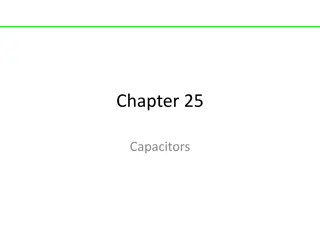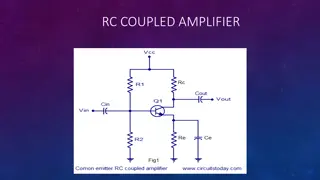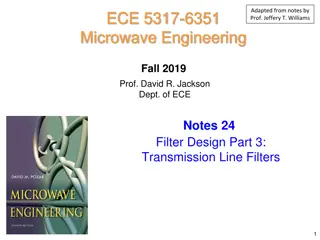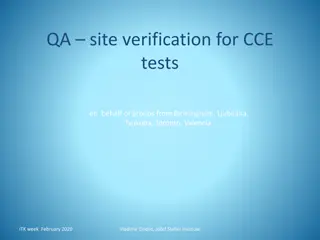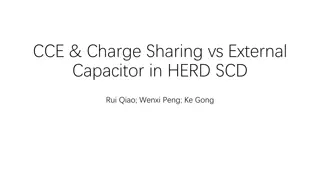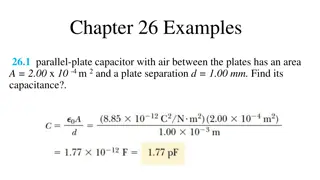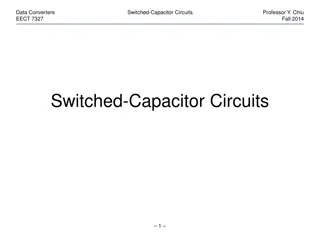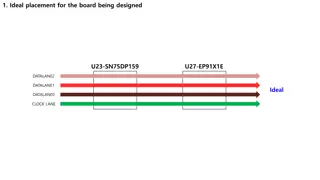High Stored Energy Emergency Discharge Systems Overview
This presentation discusses the high stored energy emergency discharge systems for klystron modulators used in RFQ/DTL and MBeta applications. It covers the storage locations of energy in various capacitor banks, the components of the system, and safety measures. The content includes detailed diagra
7 views • 10 slides
Understanding Capacitors in Physics
Capacitors are electronic components that can store electric charge and energy. This content covers various concepts related to capacitors, such as capacitance, charge storage capacity, electric fields between plates, and capacitance calculations for different geometries. Problems and examples are p
1 views • 46 slides
Enhancing Performance of EHV Lines through Series Compensation
Series compensation, involving connecting capacitors in series with electrical transmission lines, aims to improve EHV line performance by decreasing transmission impedance and enhancing voltage stability and transient stability. The method is a robust tool to optimize power transmission efficiency.
0 views • 51 slides
Understanding Waveform Generators in Electronic Circuits
Waveform generators, such as square wave oscillators and triangular wave generators, play crucial roles in electronic circuits. Square wave oscillators use capacitors and op-amps to create square wave outputs through charging and discharging processes. On the other hand, triangular wave generators u
1 views • 11 slides
Overview of Multivibrators: Types and Applications
Multivibrators are electronic circuits used for various applications such as oscillators, timers, and flip-flops. They consist of two amplifying devices cross-coupled by resistors or capacitors. The three main types are astable, monostable, and bistable multivibrators, each serving different purpose
0 views • 10 slides
Analysis of Low-Frequency Response in BJT and FET Amplifiers
This analysis delves into the low-frequency response of BJT and FET amplifiers, examining the impact of various components such as resistors and capacitors on the cutoff frequencies. Detailed examples illustrate the calculation process for determining these frequencies based on specific parameters.
0 views • 18 slides
Understanding RC Coupled Amplifiers and Transistor Basics
Amplification is the process of increasing signal strength without changing its characteristics. An RC coupled amplifier is a multistage amplifier using resistors and capacitors. Transistor amplifiers amplify signals based on transistors with different configurations. The common emitter configuratio
0 views • 23 slides
Microwave Filter Design Using Transmission Lines
Explore the design of microwave filters using transmission lines, starting with lumped-element designs and transitioning to transmission line approximations. Learn how to realize series inductors and shunt capacitors using narrow and wide sections of microstrip lines. Discover techniques such as Ric
0 views • 28 slides
Understanding Diode Applications in Modern Electronic Systems
Diodes are essential semiconductor components with various applications in electronic systems. They allow current flow in one direction, serving as one-way switches. Diodes are used in communication systems, computers, power supplies, televisions, radar circuits, and more. One significant applicatio
1 views • 19 slides
Understanding Capacitor Behavior in AC Circuits
Capacitors exhibit unique behaviors in AC circuits, transitioning from transient to steady states. By analyzing the interaction between source voltage and capacitance, we can derive key relationships such as phase differences and power transfers. Understanding these principles is essential for desig
0 views • 16 slides
Understanding Operational Amplifiers (Op-Amps) and Their Applications
Operational Amplifiers (Op-Amps) are devices used to amplify signals using an external power source. They are composed of transistors, resistors, and capacitors. Op-Amps find applications in summing amplifiers, AC and DC signal processing, digital-to-analog converters, active filters, oscillators, r
1 views • 41 slides
Quality Assurance for CCE Tests at Multiple International Sites
This document outlines the quality assurance procedures for CCE tests conducted on behalf of groups from Birmingham, Ljubljana, Tsukuba, Toronto, and Valencia during the ITK week in February 2020. It covers site verifications, irradiation and test sites, testing procedures, fluence measurements, and
0 views • 11 slides
Electric Circuits: Series and Parallel Configurations Explained
In this lecture on electric circuits, we delve into series and parallel circuits featuring batteries, wires, resistors, and capacitors. Key concepts discussed include Kirchhoff's loop rule, series components, and equivalent resistance and capacitance. Learn how to simplify complex circuits and analy
0 views • 24 slides
Capacitor Problems and Solutions
Explore a series of capacitor-related problems, including calculating charge, radius, capacitance, electric field, and more. Dive into scenarios involving capacitors connected to batteries, liquid drops with capacitance, Earth and cloud layers as capacitor plates, air-filled capacitors, surface char
0 views • 18 slides
Comparison of Charge Sharing Mechanisms in HERD SCD
This study delves into the analysis of charge sharing mechanisms in the HERD SCD using simulations and experimental data. It explores the impact of coupling capacitors on charge sharing efficiency and readout strip performance under various conditions to enhance signal detection and improve CCE. The
0 views • 21 slides
Understanding the Ignition System in Internal Combustion Engines
The ignition system in spark ignition engines initiates combustion through electric discharge across the spark plug electrodes. It ensures proper ignition timing for efficient engine operation at various speeds and loads. Modern ignition systems include battery, magneto, and electronic ignition type
0 views • 21 slides
Understanding Electric Currents and Resistance II in Physics
Capacitors, resistance, energy usage, and the microscopic picture of conductivity are explored in this lecture on electric currents and resistance II in Physics 2415. Discover the relationship between voltage, charge, current, and resistance, along with insights into power usage, resistivity, and th
0 views • 22 slides
Tuning and Matching of 1 and 2 Loops Antenna
The aim of the project is to match the impedance of the circuit to 50 ohms at the resonance frequency of 14.8 MHz. The process involves calculating the impedance, working at low frequencies to determine key parameters, calculating capacitors, determining Q, and finally calculating tuning and matchin
0 views • 25 slides
Understanding Capacitors in Electric Circuits
Exploring various scenarios involving capacitors in electric circuits, from analyzing the electric field between capacitor plates to determining stored energy and capacitance differences. Topics covered include equilibrium charge distribution, potential energy comparison, and stability of interconne
0 views • 7 slides
Capacitors: Examples and Applications
Explore examples of parallel-plate capacitors with varying dimensions and configurations, calculating capacitance, maximum charge, and energy storage. Understand how capacitors behave in circuits and how to determine equivalent capacitance in complex setups.
0 views • 9 slides
Understanding Capacitors and Supercapacitors: A Comprehensive Overview
Uncover the rich history of capacitors, electrolytic capacitors, and supercapacitors, tracing back to the 18th century. Explore the differences between batteries and supercapacitors, delve into the application of supercapacitors, and learn about the fascinating development of double-layer electrolyt
0 views • 15 slides
Switched-Capacitor Circuits in Data Converters: Fall 2014 by Professor Y. Chiu
Explore the concepts of switched-capacitor circuits in data converters through the teachings of Professor Y. Chiu during the Fall 2014 semester. Delve into topics such as continuous-time integrators, switched capacitors, discrete-time integrators, and shunt-type vs. series-type capacitors in a compr
0 views • 57 slides
Comprehensive Study on XFAB SOI Technology for Digital Electronics
Analog building blocks using XFAB SOI technology with adjustable feedback capacitors, slow and fast shapers, simulation results, linearity up to 8.36 pC, discriminator efficiency, and Monte Carlo analysis. Issues regarding noise contributions and feedback capacitance are also discussed. Presented at
0 views • 13 slides
Ideal Placement for Board Design with U23-SN75DP159 and U27-EP91X1E
The current status of the board under design includes various components such as resistors, capacitors, and integrated circuits (ICs) like PLL_XFC-2. Connections for TMDS_D2P, TMDS_D2N, TMDS_D1P, TMDS_D1N, TMDS_D0P, TMDS_D0N, and TMDS_CLKP are detailed. Additionally, there are references to HDMI int
0 views • 7 slides
Understanding Second-Order RLC Circuits in Electronics
Explore second-order RLC circuits in electronics, characterized by second-order differential equations and involving resistors, inductors, capacitors, and voltage sources. Learn about initial and final values of voltage and current, applications in filters, and the differential equations governing t
0 views • 13 slides
Understanding Coilguns: A Comprehensive Overview of Coilgun Design and Operation
Coilguns, also known as Gauss guns, accelerate pieces of iron or steel using electromagnetic coils, creating a powerful magnetic field. This overview covers the principles behind coilguns, including magnetic materials, solenoid physics, energy storage in capacitors, and the role of inductors in damp
0 views • 26 slides
Understanding Magnetism and Inductance in Physics
Explore the concepts of magnetism, inductance, and inductors in physics, including circuit diagram symbols, energy storage, calculations in RL circuits, and determining inductance. Learn about the differences between inductors and capacitors, as well as the properties and applications of solenoids.
1 views • 14 slides
Lemon-Powered Car Experiment: Creating Electricity from Citrus Cells
The Lemon-Powered Car experiment involves determining the potency of reducing agents, creating chemical cells to generate electricity, utilizing capacitors to store and release energy, and building a car powered by a chemical reaction. Key concepts covered include redox reactions, batteries, capacit
0 views • 21 slides
Understanding Natural Response in Electrical Engineering
In this lecture on Introduction to Electrical Engineering, the concept of natural response in circuits involving inductors and capacitors is explored. The process of energizing the components to a steady state, letting the circuit settle naturally, and analyzing the state of inductors and capacitors
0 views • 37 slides
Renewable Energy Lab: Exploring Solar, Wind, and Hydrogen Technologies
Explore the capabilities of solar panels, wind turbines, hydrogen fuel cells, and capacitors in this Renewable Energy Lab. Learn about the harnessed clean energy sources, including solar panels converting sunlight to electricity and wind turbine technology utilizing wind pressure. Design a renewable
0 views • 18 slides
Evolution of Amplifiers: From WWII to Modern Integrated Circuits
Amplifiers have come a long way since their invention during WWII for mathematical operations. The modern amplifier is compact, high-performing, and integrated with transistors, resistors, and capacitors on a single chip. The properties of operation amplifiers, input modes, and differential inputs a
0 views • 10 slides
Exploring Electronic Alarm Circuits and Devices
Discover the workings of various electronic alarm circuits such as Frost Alarm, Fire Alarm, and Burglar Alarm. Learn how different sensors and components like thermistors, resistors, transistors, and capacitors are utilized to trigger alarms based on temperature changes, light conditions, and time d
0 views • 23 slides
Metamaterial-Based Series Connected Rectangular Patch Antenna Array for UHF RFID Readers
The metamaterial-based UHF RFID reader antenna array comprises features like rectangular patches, inter-digital capacitors, tuning stub, and a series fed array. The prototype dimensions and substrate details are provided along with resonant frequency observations. Test results include S-parameters o
0 views • 15 slides

